20 Birds With Red Chests (with Pictures)
Last Updated on
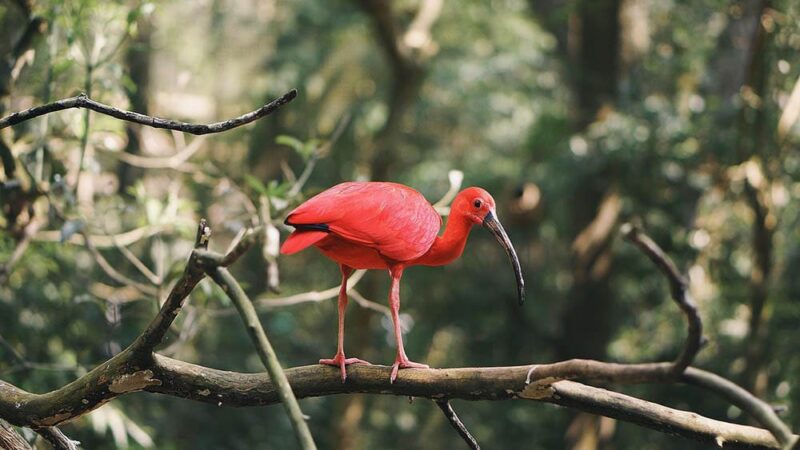
Few colors attract our eyes the way that red does. So, it’s no surprise that when you see a bird with a red breast, you want to know what it is!
Whether you’re trying to identify a bird that you’ve already spotted or want to know where you can go to spot more, you’ve come to the right place. Here, we highlighted 20 different bird species with red chests, so there’s a good chance that what you’re looking for is here!

The 20 Birds with Red Chests
1. American Robin
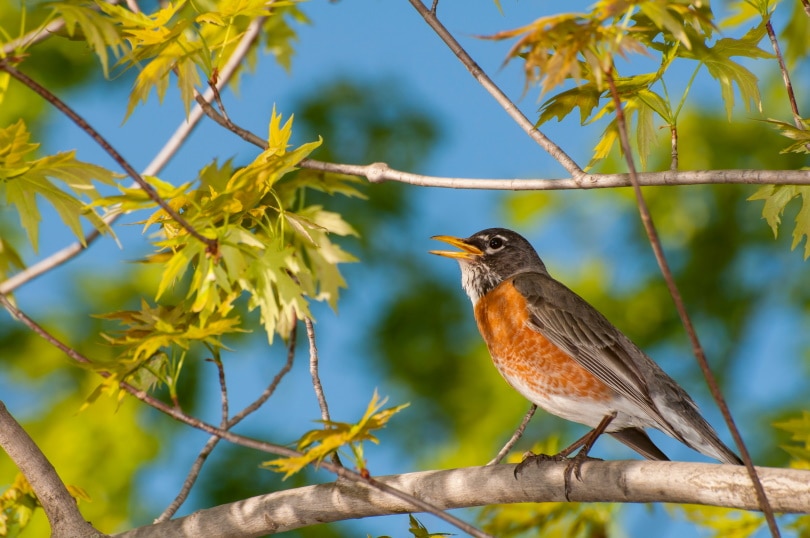
| Scientific Name: | Tirdus migratorius |
| Population: | 370 million |
| Region: | North America |
| Diet: | Insects, berries, and earthworms |
While the American robin doesn’t have the reddest chest of all the birds out there, it does have a distinct red hue. It’s also by far the most populous bird with this coloring. If you live in North America and keep an eye out, chances are that you’ll spot an American robin in no time.
2. Painted Bunting

| Scientific Name: | Passerina ciris |
| Population: | 15 million |
| Region: | North America |
| Diet: | Seeds and insects |
If you spot a painted bunting, you’re going to remember it. Not only does it have a bright red chest, but it also has shades of deep blue, green, and yellow. It’s not as populous as the American Robin, but it’s a stunning bird if you can spot one!
3. House Finch
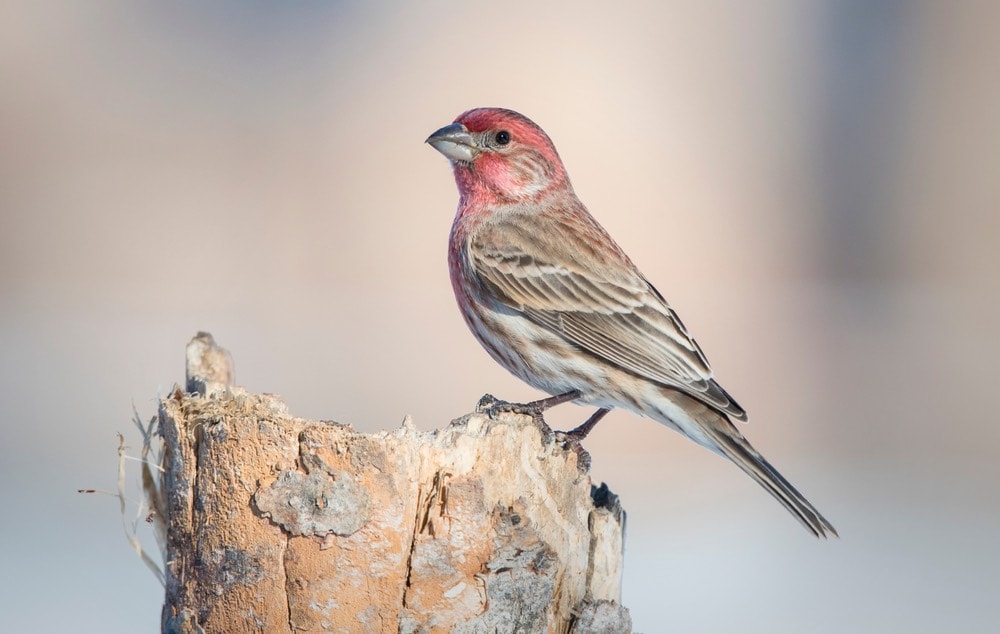
| Scientific Name: | Haemorhous mexicanus |
| Population: | 40 million |
| Region: | North America |
| Diet: | Weed seeds, berries, small fruits, and insects |
There are tons of different finches in the world, and the most common is the house finch. However, if you’re looking for a house finch with a red chest, you’ll need to find a male. Females are completely gray, but males will have a red hue around both the face and chest.
4. Cassin Finch

| Scientific Name: | Haemorhous cassinii |
| Population: | 3 million |
| Region: | Western North America |
| Diet: | Seeds, buds, berries, and insects |
Just like with the house finch, if you’re trying to spot a Cassin finch with a red chest, you’ll have to find a male. The main visible difference between a house finch and a Cassin finch is that the latter has a tuft on the top of the head.
The male’s chest isn’t bright red, but it does have a distinguishable red tint that you can’t miss.
5. Summer Tanager
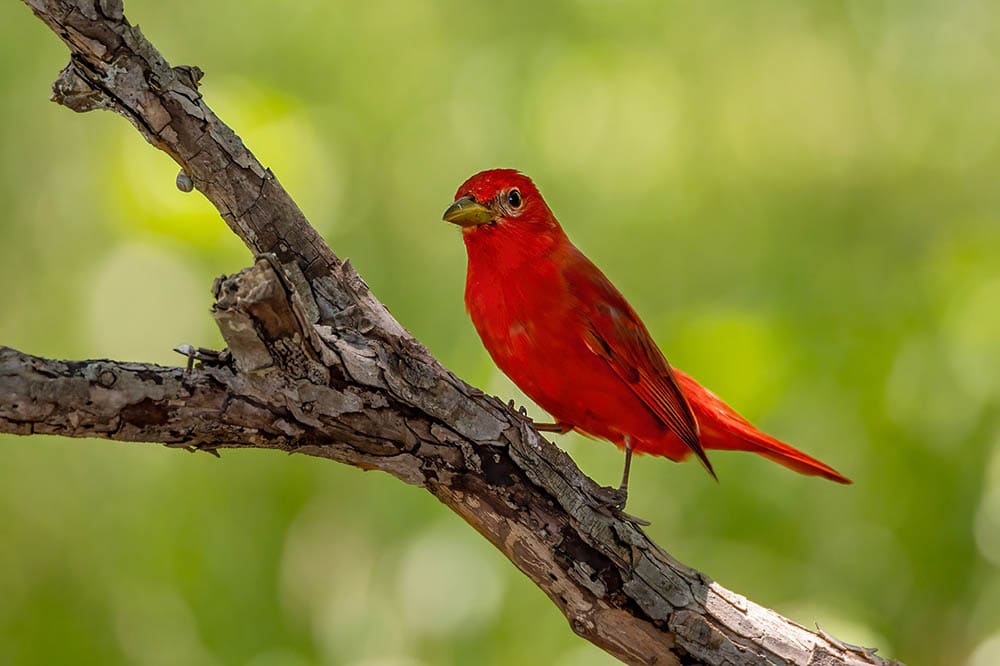
| Scientific Name: | Piranga rubra |
| Population: | 12 million |
| Region: | Central and South America |
| Diet: | Insects |
Some birds have red hues, and some birds, like the summer tanager, are red all over. Male and female summer tanagers look completely different from each other, as females are a bright yellow and green, but if you spot an adult male, it will be completely red.
6. Hepatic Tanager

| Scientific Name: | Piranga flava |
| Population: | 7.6 million |
| Region: | Southern North America, Central America, and South America |
| Diet: | Insects |
While not every hepatic tanager is a bright shade of red, all the males have a distinctive red/orange appearance. The females don’t have this red hue, though. They are a yellow/gray color.
7. Vermilion Flycatcher
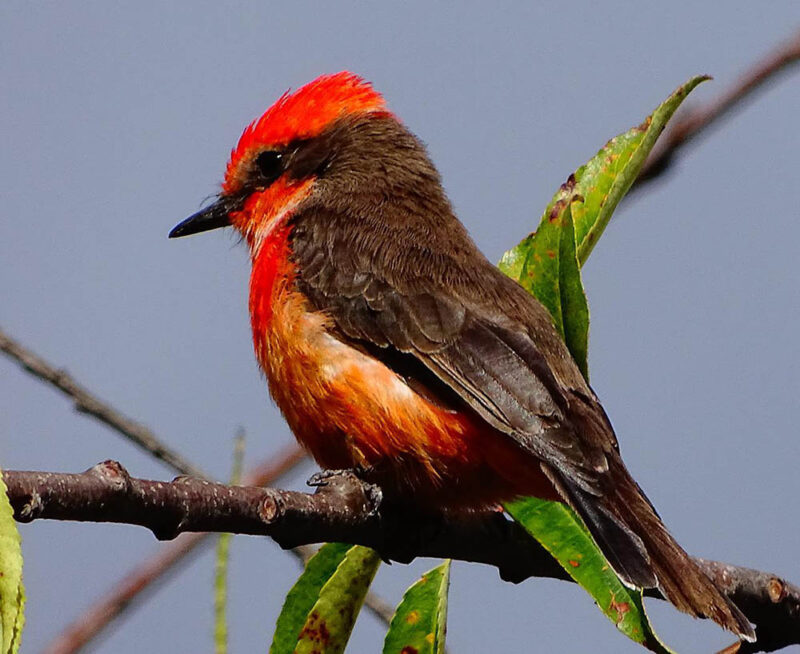
| Scientific Name: | Pyrocephalus obscurus |
| Population: | 560,000 |
| Region: | Southern North America |
| Diet: | Flying insects |
While there aren’t many of these birds in the world, if you spot a male vermilion flycatcher, chances are that you’ll remember it. The male has a bright-red chest and a bright-red tuft on its head, with a brown band around its eyes and on its wings.
Females don’t have the same bright-red hue though, so if you spot a female or adolescent vermilion flycatcher, it won’t have a red chest.
8. Rose-Breasted Grosbeak
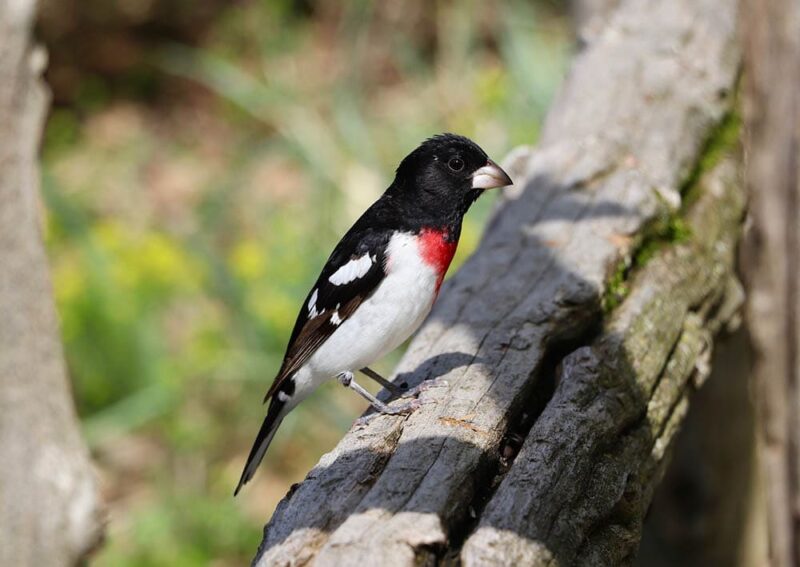
| Scientific Name: | Pheucticus ludovicianus |
| Population: | 4.1 million |
| Region: | Eastern North America, Central America, and northern South America |
| Diet: | Insects, seeds, and berries |
Many of the birds on this list have a red hue throughout. That’s not the case with the rose-breasted grosbeak. The male has a bright-red coloring on its chest under its head, but that’s the only part of its body with any red.
Females don’t have this coloring here, so if you spot a red chest on a rose-breasted grosbeak, you’ve found a male.
9. Pyrrhuloxia
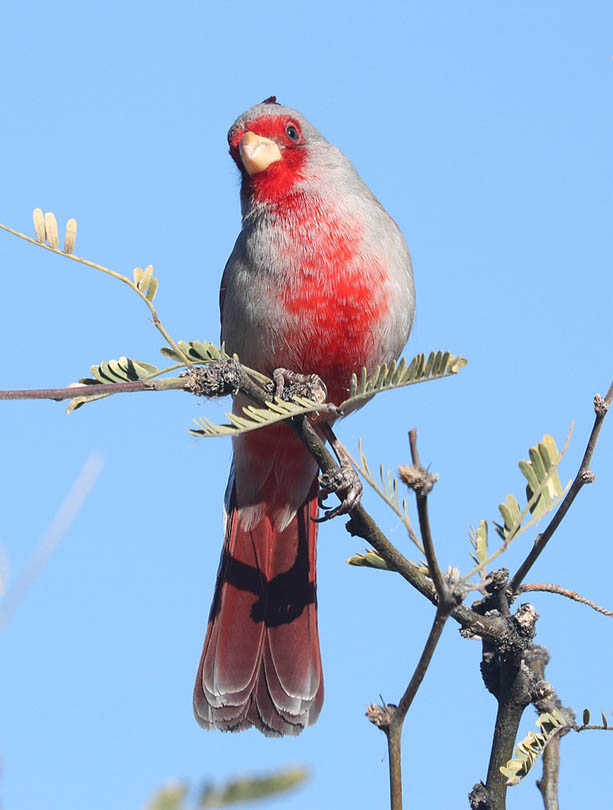
| Scientific Name: | Cardinalis sinuatus |
| Population: | 3 million |
| Region: | Southern North America |
| Diet: | Insects, seeds, berries, and wild fruits |
The pyrrhuloxia doesn’t have a single color throughout, but if you get a good enough look, you’ll definitely notice some red around its body, especially on its chest. Both female and male pyrrhuloxias have red streaks, but it’s more prominent on males.
If you’re looking to spot a pyrrhuloxia, you’ll need to head to the desert regions in southern North America, as that’s the only region that they live in.
10. Red-Breasted Sapsucker
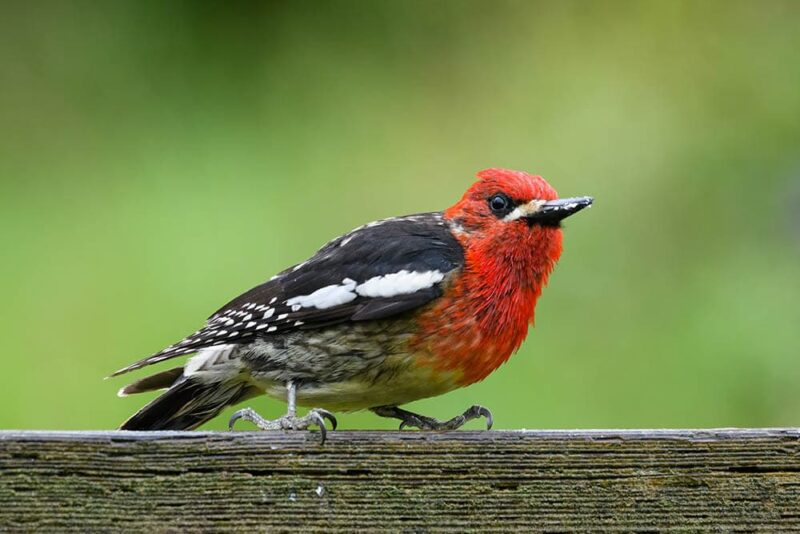
| Scientific Name: | Sphyrapicus ruber |
| Population: | 2.8 million |
| Region: | West coast of North America |
| Diet: | Insects, tree sap, and fruit |
When you think of red-breasted birds, you don’t always think of woodpeckers, but the red-breasted sapsucker has a red hue around its head and chest. They have a narrow range along the west coast of North America but a decently large population.
11. Scarlet Robin
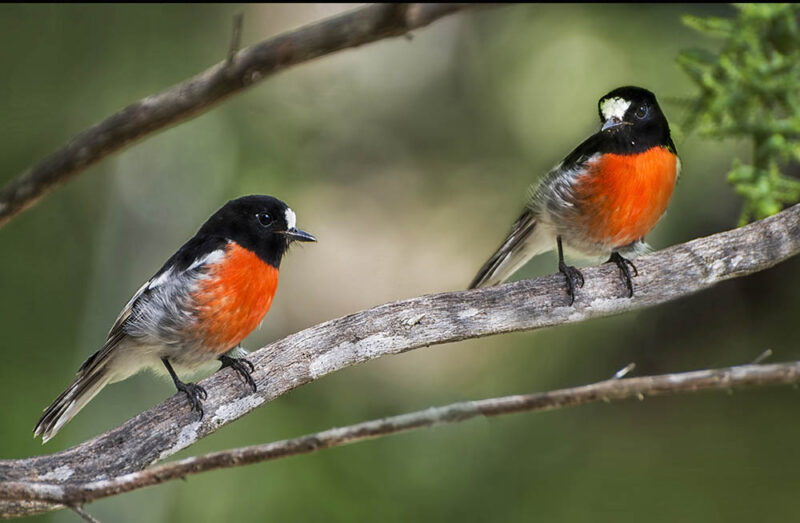
| Scientific Name: | Petrocia boodang |
| Population: | Unknown |
| Region: | Australia |
| Diet: | Insects |
While you’ll find most of the red-breasted birds on this list in the western hemisphere, the scarlet robin is a notable exception. While there are no exact population numbers, the species is stable, and it seems like there are quite a few of these birds in Australia.
It has a black head and a reddish, or orange chest. If you’re in the land down under and see a red-breasted bird, there’s a good chance that it’s a scarlet robin.
12. White-Winged Crossbill
| Scientific Name: | Loxia leucoptera |
| Population: | 79 million |
| Region: | Northern North America |
| Diet: | Seeds and insects |
The white-winged crossbill is a bird that only has a red chest if it’s a male. It has a much more northern range compared to most of the other birds on this list, with the majority of the population residing in Canada.
These birds always stay in flocks, so if you spot one white-winged crossbill, you know that there are plenty more around.
13. Elegant Trogons
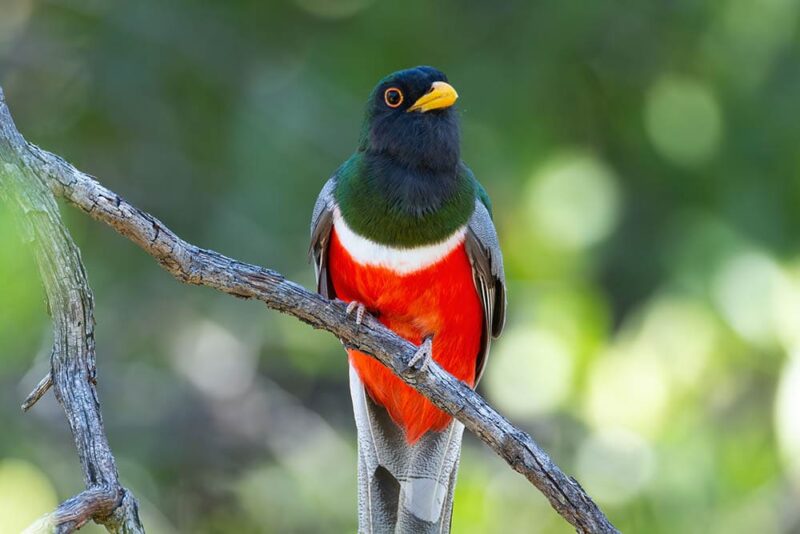
| Scientific Name: | Trogon elegans |
| Population: | 200,000 |
| Region: | Southern North America and Central America |
| Diet: | Insects and fruit |
If you’re trying to spot a red-breasted bird in southern North America and want a bit of a challenge, try to spot an elegant trogon. Not only do they have a small population and range, but only males have the distinctive red hue.
14. Scarlet Tanager
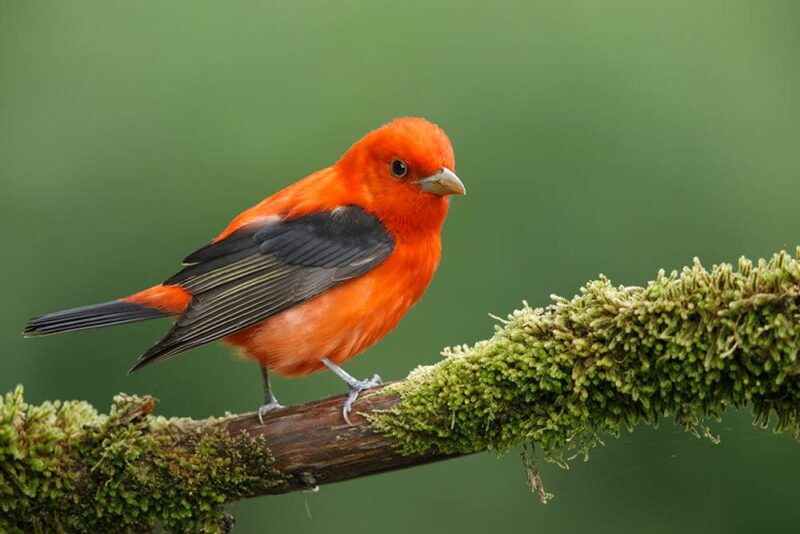
| Scientific Name: | Piranga olivacea |
| Population: | 2.6 million |
| Region: | Eastern North America, Central America, and north-western South America |
| Diet: | Insects and berries |
If you’re looking for the reddest tanager out there, the scarlet tanager might just take that win. Females and adolescents are a green/yellow color, but if you spot a male, you won’t miss the distinctive red hue.
Only their wings and tail feathers aren’t bright red, but those black feathers only make the red on their bodies stand out even more.
15. Red-Crested Cardinal
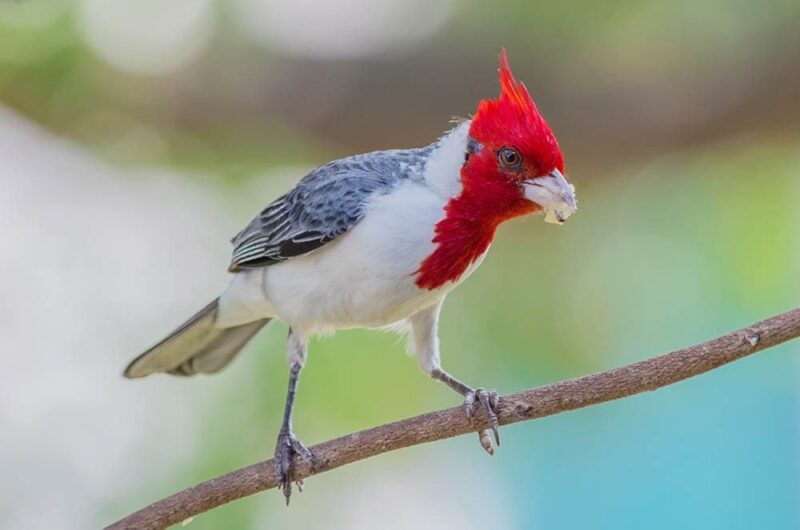
| Scientific Name: | Paroaria coronate |
| Population: | Unknown |
| Region: | Japan |
| Diet: | Fruit, seeds, and insects |
The red-crested cardinal population is currently declining, which has almost everything to do with how small their range is. You can only find these birds in a small area in Japan, but if you go there, there are quite a few of them.
16. Northern Cardinal
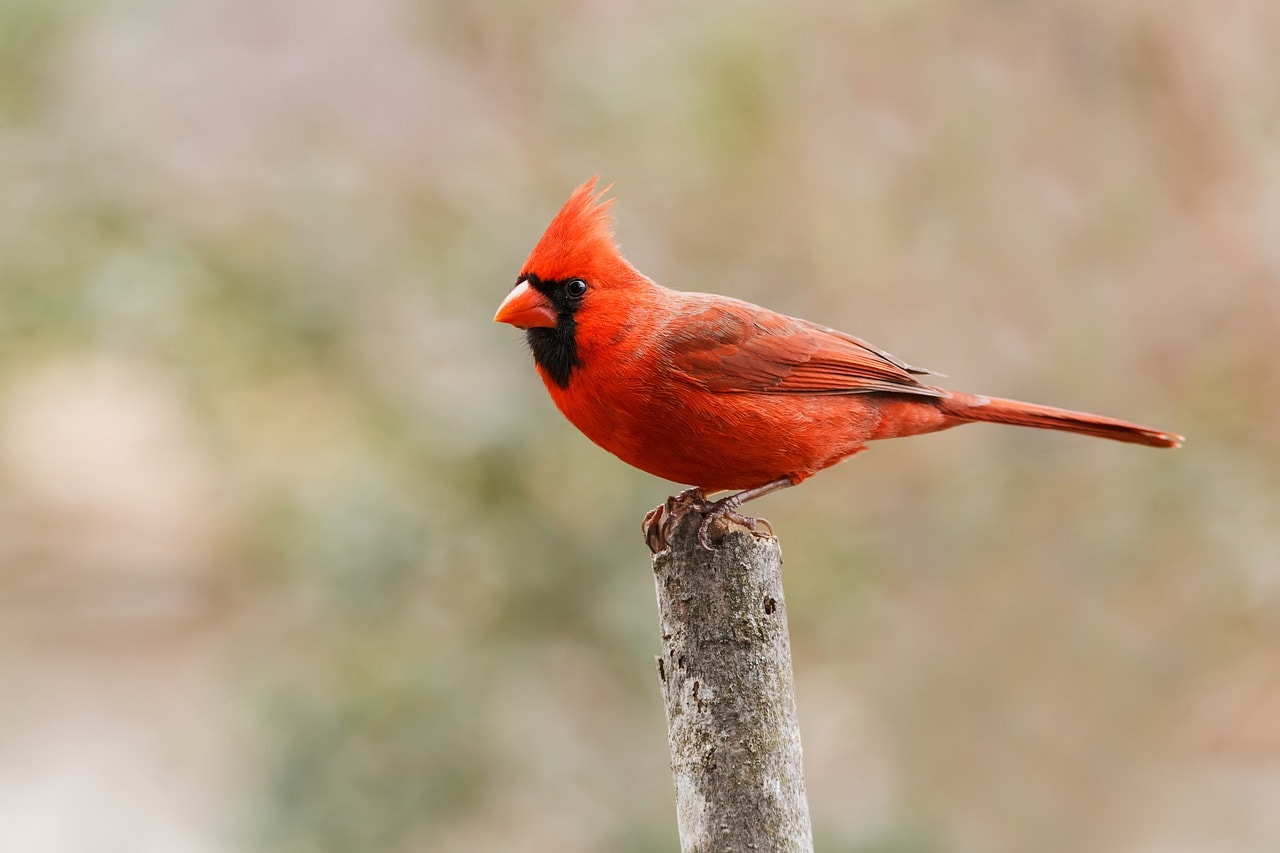
| Scientific Name: | Cardinalis |
| Population: | 120 million |
| Region: | North America |
| Diet: | Insects, seeds, weeds, flowers, leaf buds, berries, and wild fruit |
You can’t talk about red birds of any kind without bringing up the cardinal. It lives in North America, and while it’s not as populous as the American robin, there are still tons of northern cardinals out there.
Only males have the bright-red hue, though; females are more brown than red. The northern cardinal is a favorite around bird feeders throughout the year.
17. Scarlet Honeycreeper (‘I’iwi)
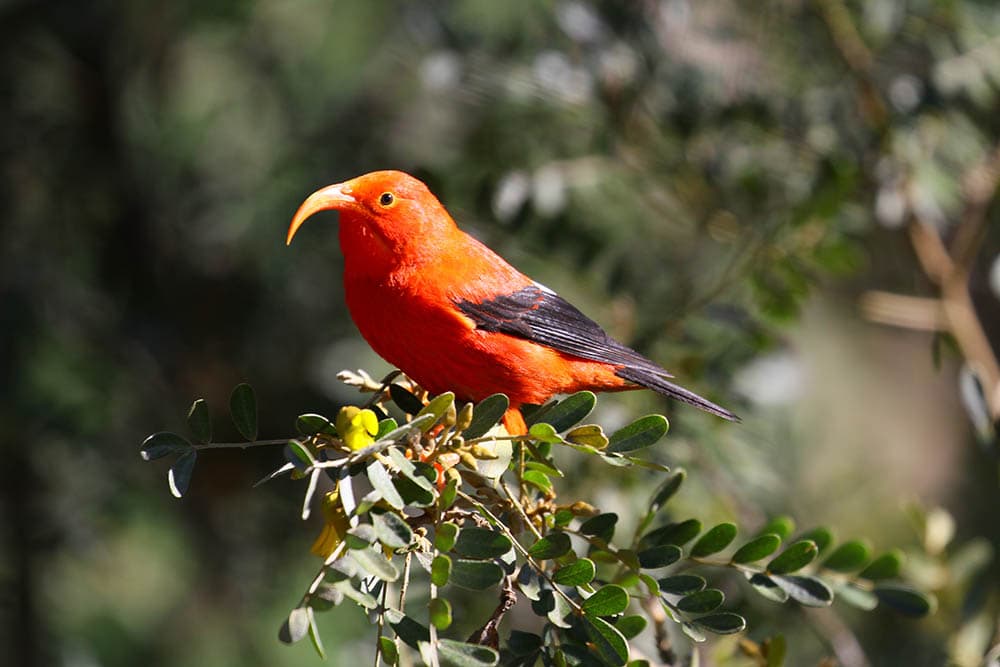
| Scientific Name: | Drepanis coccinea |
| Population: | 600,000 |
| Region: | Hawaii |
| Diet: | Nectar and arthropods |
If you’re out in Hawaii and see a red bird, there’s a good chance that you have spotted a scarlet honeycreeper. Also known as the ‘I’iwi, this bird is currently undergoing a significant population decline.
It thrives on nectar and arthropods, but due to various environmental factors, the future of these beautiful red birds is in question.
18. Scarlet Honeyeater

| Scientific Name: | Myzomeal sanguinolenta |
| Population: | Unknown |
| Region: | Australia |
| Diet: | Fruit and insects |
The scarlet honeyeater is an Australian red-chested bird. Only the males have a red chest, though, as females and adolescents are a gray/white color.
These birds eat fruits and insects, and while their numbers are unknown, it doesn’t seem like their population is in decline. There appears to be an abundance of these tiny birds in the country.
19. Scarlet Ibis
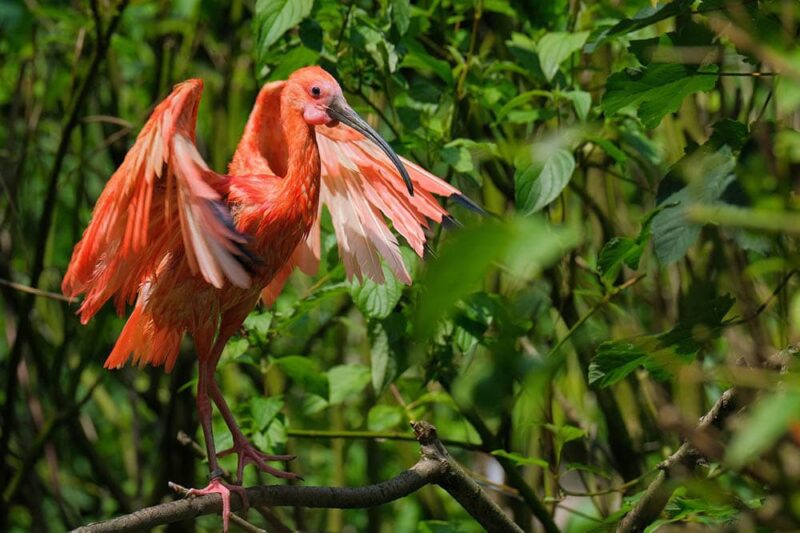
| Scientific Name: | Eudocimus ruber |
| Population: | 100,000 to 150,000 |
| Region: | South America and Caribbean Islands |
| Diet: | Fish, worms, insects, and crustaceans |
Not only does the scarlet ibis have a small range, but there are also not many of these birds left. Their population numbers are increasing but at a fairly slow pace. Every part of this bird is bright red, making it hard to miss if you do happen to spot one.
20. Eared Quetzal

| Scientific Name: | Euptilotis neoxenus |
| Population: | < 50,000 |
| Region: | Southern North America |
| Diet: | Insects, small vertebrates, and fruit |
If you head down the Mexican mountains, you might be lucky enough to see an eared quetzal. There doesn’t seem to be many of these birds left, even though we don’t know exactly how many are out there.
Most of this bird’s coloring is bluish/green, but a large portion of its underside has a bright orange/red hue. Like many birds, this red coloring is more pronounced on males than females.

In Conclusion
When you spot a bird with a red breast, you want to know what it is and how you can see it again! Hopefully, after reading through this guide, you can identify the bird that you saw. Moreover, we hope that you can head out and spot it again when you want to!
Featured Image Credit: Pexels, Pixabay
Table of Contents
- The 20 Birds with Red Chests
- 1. American Robin
- 2. Painted Bunting
- 3. House Finch
- 4. Cassin Finch
- 5. Summer Tanager
- 6. Hepatic Tanager
- 7. Vermilion Flycatcher
- 8. Rose-Breasted Grosbeak
- 9. Pyrrhuloxia
- 10. Red-Breasted Sapsucker
- 11. Scarlet Robin
- 12. White-Winged Crossbill
- 13. Elegant Trogons
- 14. Scarlet Tanager
- 15. Red-Crested Cardinal
- 16. Northern Cardinal
- 17. Scarlet Honeycreeper (‘I’iwi)
- 18. Scarlet Honeyeater
- 19. Scarlet Ibis
- 20. Eared Quetzal
- In Conclusion
About the Author Robert Sparks
Robert’s obsession with all things optical started early in life, when his optician father would bring home prototypes for Robert to play with. Nowadays, Robert is dedicated to helping others find the right optics for their needs. His hobbies include astronomy, astrophysics, and model building. Originally from Newark, NJ, he resides in Santa Fe, New Mexico, where the nighttime skies are filled with glittering stars.
Related Articles:
Monocular vs Telescope: Differences Explained (With Pictures)
10 Types of Hummingbirds in Arkansas (With Pictures)
8 Types of Hummingbirds in Nebraska (With Pictures)
5 Types of Hummingbirds in Idaho (With Pictures)
3 Types of Hummingbirds in Mississippi (With Pictures)
8 Types of Hummingbirds in Kansas (With Pictures)
5 Types of Hummingbirds in West Virginia (With Pictures)
5 Types of Hummingbirds in Ohio (With Pictures)
